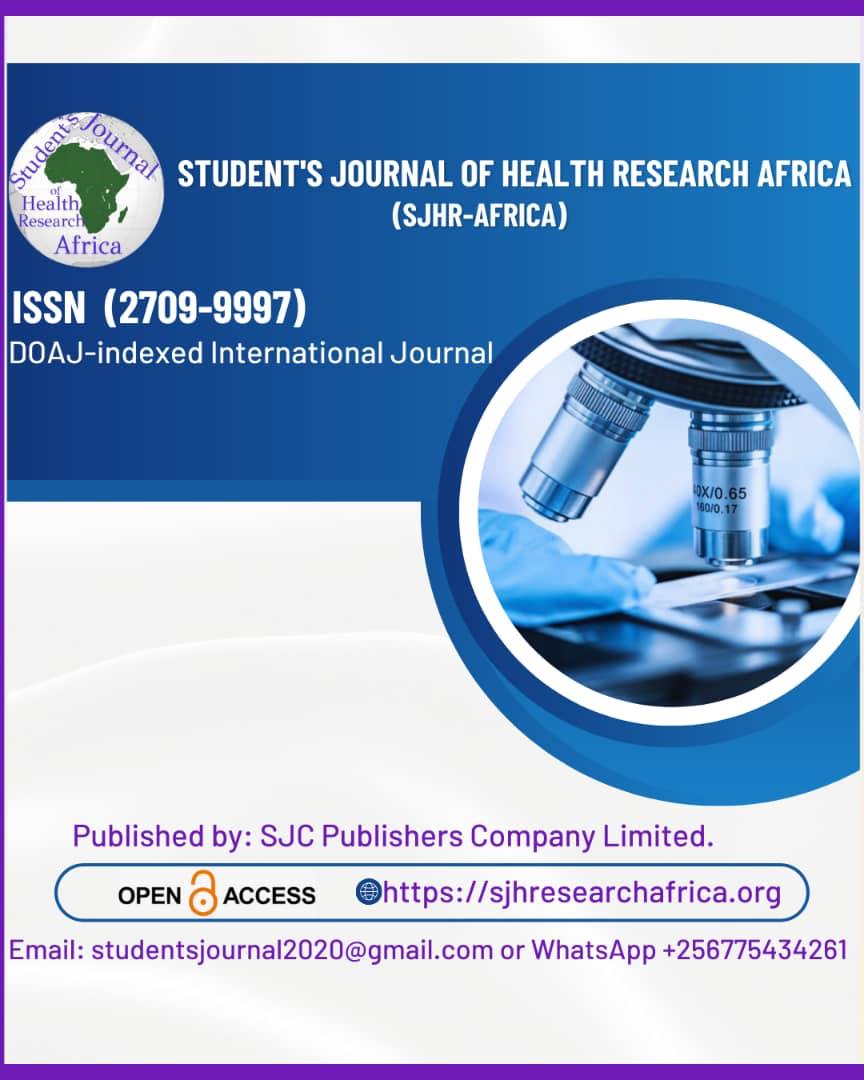Paediatric asthma prevalence and environmental factors: A community-based cross-sectional study.
DOI:
https://doi.org/10.51168/sjhrafrica.v6i3.1784Keywords:
Pediatric asthma, Environmental factors, Socio-economic status, Indoor air quality, Outdoor air pollutionAbstract
Background
Pediatric asthma is a critical public health issue with its origins in a complex array of environmental, socio-economic, and potentially genetic factors. Understanding these can aid in crafting targeted preventive measures and management strategies.
Aim and Objectives: This study aims to determine the prevalence of pediatric asthma within a representative sample and investigate its associations with environmental conditions, socio-economic status, and familial health history, aiming to unravel the condition's multifaceted causes.
Materials and methods
This cross-sectional analysis involved 100 children and adolescents aged 0-18 years. Through interviews and medical record reviews, data were gathered on asthma diagnoses, environmental exposures, socio-economic status, physical activity, and family health history. Chi-square tests and logistic regression analyses identified key asthma predictors.
Results
The study found a 22% prevalence of asthma, highest among 6-12-year-olds (54.5%), and more common in males (59%). Critical environmental risk factors included poor indoor air quality (affecting 73% of asthmatic children), environmental tobacco smoke exposure (40%), and high outdoor air pollution (50%). Additionally, 68% of affected children came from lower socio-economic backgrounds. The most potent asthma predictor was poor indoor air quality (odds ratio = 4.5), alongside significant influences from tobacco smoke, outdoor pollution, sedentary lifestyles, and family asthma history.
Conclusions
The study found a prevalence of pediatric asthma at 22%, with the highest burden among school-aged children and males. Environmental and socio-economic factors such as poor indoor air quality, exposure to tobacco smoke, and lower socio-economic status were significantly associated with asthma. These findings underscore the need for targeted interventions to reduce environmental exposures and improve health outcomes in children.
Recommendations
To reduce pediatric asthma prevalence, prioritize interventions targeting indoor air quality improvement, reduce exposure to tobacco smoke, address outdoor pollution, and promote physical activity, especially in socio-economically disadvantaged areas.
References
Rashmi BM, Patil SS, Sindhu BM, Patil SV. Pediatric Asthma: Prevalence and Socio-Cultural Factors Affecting Asthma Management in a Rural Area of Northern Karnataka. Indian J Community Med. 2021 Jan-Mar;46(1):24-29. https://doi.org/10.4103/ijcm.IJCM_85_20 PMid:34035571 PMCid:PMC8117888
Kinghorn B, Fretts AM, O'Leary RA, Karr CJ, Rosenfeld M, Best LG. Socioeconomic and Environmental Risk Factors for Pediatric Asthma in an American Indian Community. Acad Pediatr. 2019 Aug;19(6):631-637.
https://doi.org/10.1016/j.acap.2019.05.006 PMid:31103883
Fattore GL, Santos CA, Barreto ML. Social determinants of childhood asthma symptoms: an ecological study in urban Latin America. J Community Health. 2014 Apr;39(2):355-62. https://doi.org/10.1007/s10900-013-9769-7 PMid:24046215
Johnson AD, Fernando A, Lewin M, Fathima FN. Determinants of Childhood Asthma: A Case Control Study from a Tertiary Care Hospital in Bengaluru, South India. J Mother Child. 2023 Aug 31;27(1):107-113. doi: 10.34763/jmotherandchild 20232701.d-22-00059. PMID: 37668442; PMCID: PMC10478677.
Idris IB, Ghazi HF, Zhie KH, Khairuman KA, Yahya SK, Abd Zaim FA, Nam CW, Abdul Rasid HZ, Isa ZM. Environmental Air Pollutants as Risk Factors for Asthma Among Children Seen in Pediatric Clinics in UKMMC, Kuala Lumpur. Ann Glob Health. 2016 Jan-Feb;82(1):202-8. https://doi.org/10.1016/j.aogh.2016.01.021 PMid:27325078
Bhalla K, Nehra D, Nanda S, Verma R, Gupta A, Mehra S. Prevalence of bronchial asthma and its associated risk factors in school-going adolescents in Tier-III North Indian City. J Family Med Prim Care. 2018 Nov-Dec;7(6):1452-1457. https://doi.org/10.4103/jfmpc.jfmpc_117_18 PMid:30613541 PMCid:PMC6293925
Kelley T, Kearney GD. Insights Into the Environmental Health Burden of Childhood Asthma. Environ Health Insights. 2018 Feb 20;12:1178630218757445. https://doi.org/10.1177/1178630218757445
PMid:29497308 PMCid:PMC5824896
Zanobetti A, Ryan PH, Coull B, Brokamp C, Datta S, Blossom J, et al. Children's Respiratory and Environmental Workgroup (CREW) Consortium. Childhood Asthma Incidence, Early and Persistent Wheeze, and Neighborhood Socioeconomic Factors in the ECHO/CREW Consortium. JAMA Pediatr. 2022 Aug 1;176(8):759-767. https://doi.org/10.1001/jamapediatrics.2022.1446 PMid:35604671 PMCid:PMC9127710
Rogerson C, Owora A, Tu W, Mendonca E. The influence of social and environmental determinants of health on hospitalizations for pediatric asthma. J Asthma. 2023 Nov 27:1-10. https://doi.org/10.1080/02770903.2023.2288323 PMid:38010826 PMCid:PMC11734457
Dharmage SC, Perret JL, Custovic A. Epidemiology of Asthma in Children and Adults. Front Pediatr. 2019 Jun 18;7:246. https://doi.org/10.3389/fped.2019.00246 PMid:31275909 PMCid:PMC6591438
Hollenbach JP, Cloutier MM. Childhood Asthma Management and Environmental Triggers. Pediatr Clin North Am. 2015 Oct;62(5):1199-214. https://doi.org/10.1016/j.pcl.2015.05.011 PMid:26318947
Zanobetti A, Ryan PH, Coull BA, et al. Early-Life Exposure to Air Pollution and Childhood Asthma Cumulative Incidence in the ECHO CREW Consortium. JAMA Netw Open. 2024;7(2):e240535.
https://doi.org/10.1001/jamanetworkopen.2024.0535 PMid:38416497 PMCid:PMC10902721
Deka H, Mahanta P, Ahmed SJ, Rajbangshi MC, Konwar R, Basumatari B. Risk Factors of Childhood Asthma Among Patients Attending a Tertiary Care Centre in North-East India. J Asthma Allergy. 2022 Sep 14;15:1293-1303. https://doi.org/10.2147/JAA.S374007 PMid:36132976 PMCid:PMC9482963
Achakulwisut P, Brauer M, Hystad P, Anenberg SC. Global, national, and urban burdens of paediatric asthma incidence attributable to ambient NO2 pollution: estimates from global datasets. Lancet Planet Health. 2019 Apr;3(4):e166-e178. https://doi.org/10.1016/S2542-5196(19)30046-4 PMid:30981709
Downloads
Published
How to Cite
Issue
Section
License
Copyright (c) 2025 Dr . Nalla Krishna, Dr. Pandala Paramesh, Dr . Kavitha Vislavath, Dr. Ravinaik Nunavath, Dr. I Sridhar

This work is licensed under a Creative Commons Attribution-NonCommercial-NoDerivatives 4.0 International License.






















